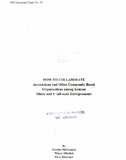| dc.description.abstract | Introduction:To survive in business today, micro and small enterprise (MSE) operators need not only to strengthen
their own entrepreneurial skills, but also to lobby for a more friendly business environment. Most find
it difficult to tackle either of these tasks alone. Many lack the time, some are not sure where to find
needed services, and others feel uncomfortable approaching policy makers or service providers.
Belonging to an association would seem to be the ideal solution. Through an association, MSEs could
collaborate to achieve what they cannot do alone.
The potential benefits appear to be obvious. Yet recent research showed that only a minority of the
owners of micro and small enterprises belong to any type of business support group (CBS et al. 1999).
Furthermore, members of such groups frequently complain that the office bearers do not adequately
represent their interests or worse that they mismanage the resources entrusted to them.
The fact that MSE operators seem to be limiting their involvement in associations suggests that these
organisations are not meeting their needs. This concern and questions about how to improve the
situation, prompted the Institute for DevelopmentStudies (IDS), University of Nairobi (UoN), to
investigate why this should be so and what, if anything, needs to be done to enable firms to collaborate
successfully. The research, which was undertaken between November 2000 and June 2001, involved
the studying of enterprises, business associations, and social organisations in rural and urban areas. The
study aimed first, at improving our understanding of these organisations, and second, at assessing their
potential for becoming more effective agents of business development and joint action.
This paper presents the findings of that research. The study examined local level associations from the
perspectives both of their leaders and their members. To gather the information, we interviewed 210
enterprises and 48 associations located in four districts around Kenya. We also visited five national
associations. Some of these were umbrell ••associations and others were simply enterprise associations
with national membership. We cross checked our findings with the respondents themselves and other
knowledgeable persons during two sets of workshops, one at district level and the second a national
workshop in Nairobi.
The paper is presented in eight chapters. Following this introduction, chapter 2 lays out the theory of
associations, and chapter 3 reviews empirical literature on associations. Charter 4 describes the study
areas and the methodology used in the study. Chapter 5 presents the material gleaned from the survey
of local level associations, while chapter 6 discusses the findings of the survey of enterprises. Chapter
7 takes up the thorny issue of umbrella associations, highlighting especially the National Federation of
Jua Kali Associations. We present our conclusions and recommendations in the final section chapter 8. | en |

